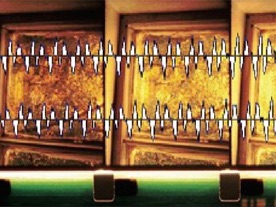Sound AND Image Relationship
The force field
Every audio-visual media experience is an encounter with the interaction of sound and image. We experience moving image works between seeing and hearing, between our eyes and ears. Even
when a film is silent our visual encounter with it interacts with an auditory experience called silence.
A force field resides between sound and image where “meaning” is created.
How do artists work with and appropriate the relationship of sound and image? What are the main methods and approaches employed by filmmakers and artists? Are there any hidden potentials in the force field between sound and image? Are there any alternative approaches?
The regime of Perception
Our engagement with the relationship of sound and image has become the most ordinary aspect of our everyday lives. We live in an environment saturated with audio-visual media. With smart phones in our pockets, iPads in our bags, Laptops on our laps, larger screens on our dinner tables and work desks, large TV screens in our living rooms, and with advertising screens that design a growing number of vitrines in the city, we have become more than accustomed to the interactions of sound and image. A parallel interaction guides the co-existence of sound and image providing our audiovisual normality. We see what we hear / we hear what we see.
The constructed unity between sound and image has become the foundation of our normality. Here is a purely fabricated phenomenon that we hardly ever question.
Having collected and studied artists’ moving image works in Norway from 1956 to 2000, we have noticed that the standardised correlation of sound and image has received almost no critical reactions in these works. Majority of the artists working with the moving image have chosen music to be at the core of their sound track. As far as we can see, critical investigation of the norms of sound and image relationship has not received much attention in the art educational institutions either. The gap between sound and image is a force field with unexplored potentials.
Method
Our research requires qualitative observation of a large volume of audio-visual material. To create a pool of reference material for the research, ATOPIA is organising several programs of artists moving image works from different parts of the world. These curated video programs will focus on the relationship of sound and image as constructed by artists of those regions. We estimate that about 50 artists works will be included in the programs. All the artists will be interviewed regarding their approach to the sound and image relationship. The making of these video programs could be considered as our main fieldwork. We will focus on central locations for the production of artists’ works such as The UK, The US, France, Germany, The Netherlands as well as Scandinavian countries. ATOPIA relies on its international network and collaborators to produce the programs.
As for additional data we will rely on Atopia’s previous research, collection and publications. Almost all the known Norwegian artists’ moving image works from 1956 to 2000 are in the collection of ATOPIA and available for research.
This project will lead to a series of seminars and presentations in 2017-19 that will be announced later.
Exhibition
Curated video programs as a survey of artists’ approach to sound and image relationship will be available for exhibitions and screenings at art venues around the country and internationally.
Nordic Collaborating Organisations:
(Sound AND Image Study Group)
Filmverkstaden, Vaasa, Finland
Fylkingen, Stockholm, Sweden
Kinosmidja, Reykjavik, Iceland
We welcome additional collaborating artists and organisations who wish to join us in this project.

An International Collaborative Research project
© Atopia Stiftelse, 2017 -

